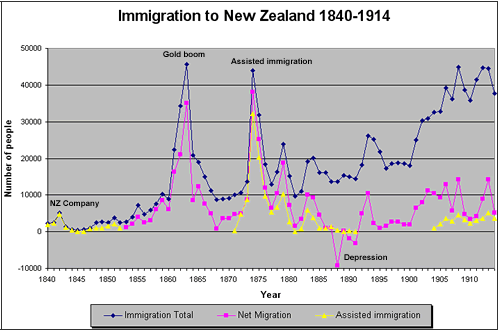This graph charts the immigrants from all countries who came to New Zealand from 1840 to 1914. This includes those who migrated from places such as Germany, Italy, Scandinavia, and most significantly Australia. However since about 90% of those who reached New Zealand shores were born in Britain or Ireland, the graph does provide a good chronology of the inflows of the British and Irish. The blue line represents the total annual inflow. The yellow line represents the net inflow after subtracting those who left New Zealand. The blue line represents those who received assisted passages to New Zealand — in the 1840s from the New Zealand Company, and after 1871 from the New Zealand Government. Those assisted by the provinces are not included.
Immigration to New Zealand 1840-1914

Before 1840: the first non-Māori settlers
In 1840 there were about 2000 non-Māori living in New Zealand, although the numbers of British people who had lived temporarily in New Zealand was much greater. In the years since 1792 when a group of sealers in Dusky Sound became the first non-Māori to make homes in New Zealand, the country was an extension of the commercial world of Sydney. Many of the early British settlers came via New South Wales. Some were sealers or whalers; others were escaped convicts seeking a new chance; others were traders linking the mercantile world with the Māori communities; and a few came as missionaries bringing the gospel to the 'heathen'.
1840–52: New Zealand Company, Australian and military immigrants
During this period there were three main flows of British and Irish migrants. The largest number came as assisted immigrants to the five New Zealand Company Settlements — in 1840–2 they migrated to Wellington, Nelson and New Plymouth, and then from 1848–52 there was a renewed assisted migration first to Otago and then to Canterbury. The second flow was of free migrants, many coming across the Tasman. They made a major contribution to the population of Auckland province, and included a substantial number of Irish background. Third there was a military stream — over 700 men who were discharged from British regiments which had come to New Zealand for the Northern War of 1845–6 and over 2500 men, women and children who came to New Zealand as the Royal New Zealand Fencibles to provide military protection in the area south of Auckland. There were also some smaller groups such as the 514 people from Paisley, near Glasgow who came out to Auckland in 1842.
1853–70: gold boom and war
During this period the non-Māori population of New Zealand increased from about 20,000 to over 250,000. It was a period of provincial government and the provinces made a substantial contribution to migration from Britain and Ireland by providing assistance with fares, and in the case of Auckland by land grants of 40 acres. Another major contributor was the lure of gold following the discoveries in Otago in 1861 and Westland in 1865. 1863 saw a gross migration to New Zealand of 45,730 people, the largest annual figure in New Zealand's history. Many of these people flowed across the Tasman, especially from the Victorian gold fields. War between the settlers and the Māori again provided a reason for settlement. Following the renewed outbreak of fighting in 1861, a number of imperial regiments came to New Zealand and eventually over 2000 men took their discharge in the colony. In addition there were over 6000 military settlers in the Auckland area. Finally there were also significant special settlements, the most famous of which were the Highland Scots who came to Waipū in Northland from 1853 after some forty years in Nova Scotia. In all about 800 people had migrated to Waipū by 1860.
1871–80: government-assisted immigration
From 1871 the New Zealand Government began to offer assisted passages to selected migrants and those people nominated by relatives. This was part of Julius Vogel's ambitious scheme to develop New Zealand. The total number of assisted migrants during the decade was over 100,000, which represented over half of the gross migration to New Zealand in those years. 1874 saw over 32,000 assisted migrants and the greatest level of annual net migration ever.
1881–1914: depression and a return to prosperity
The economic difficulties of the 1880s and early 1890s made New Zealand a less attractive option for migrants. Assistance was finally terminated during the late 1880s and 1891 saw the last small group of assisted migrants arrive. With Victoria still booming there was a large out-migration across the Tasman and 1888 saw a net decline of over 9,000 people. There was a brief revival of migration during the early 1890s before returning prosperity from the turn of the century began to make New Zealand once more an attractive destination. The numbers increased especially once assisted migration was restored in 1904. The early years of the century also saw a significant inflow of British people from Australia.



